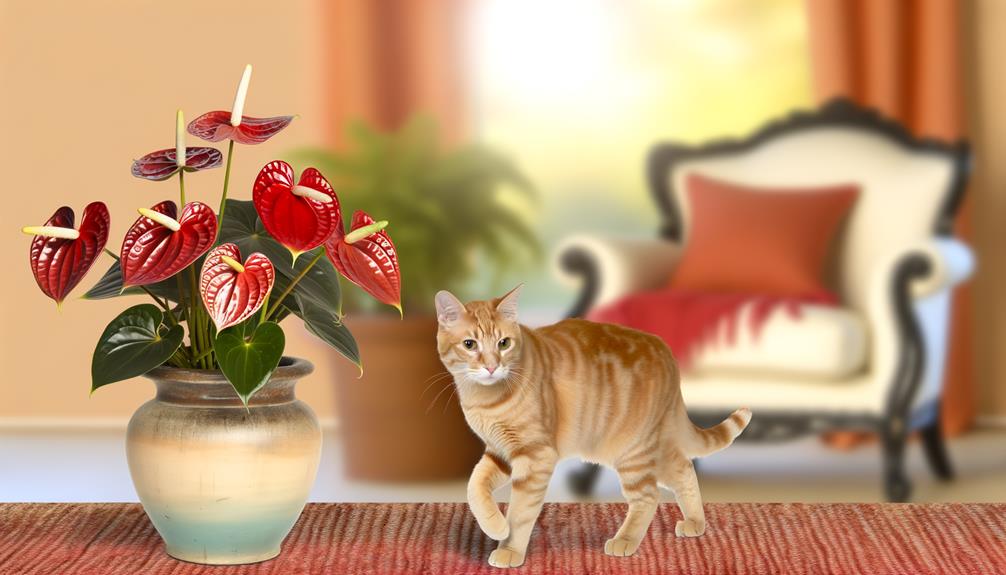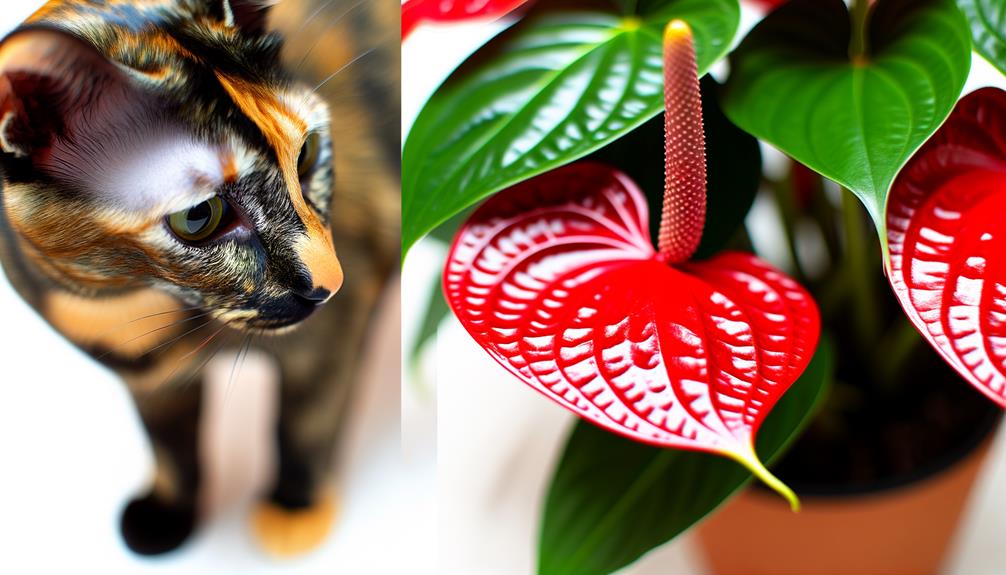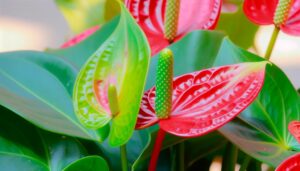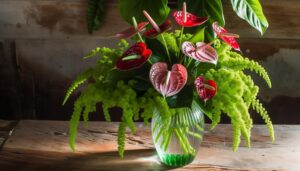Anthuriums Poisonous to Cats: Safety Tips for Pet Owners
Anthuriums contain insoluble calcium oxalate crystals, causing severe irritation and swelling in cats. Symptoms include drooling, vomiting, and pawing at the mouth.
In severe cases, cats might experience respiratory distress. Rinse your cat’s mouth with water immediately and contact a vet.
Avoid inducing vomiting without professional advice. Veterinarians may administer intravenous fluids and anti-inflammatory medications.
Preventing access to anthuriums and opting for non-toxic plants like spider plants or Boston ferns is essential. Continual vigilance and proper plant choices guarantee your cat’s safety and well-being.
Stay informed to effectively protect your pet from toxic plants.

Key Takeaways
- Keep anthuriums out of reach to prevent accidental ingestion by cats.
- Recognize symptoms like drooling and vomiting as signs of poisoning.
- Rinse the cat’s mouth immediately if anthurium ingestion is suspected.
- Consult a veterinarian promptly for appropriate treatment and guidance.
- Opt for non-toxic plants like spider plants and Boston ferns to ensure safety.
Why Anthuriums Are Toxic

Anthuriums are toxic to cats because they contain insoluble calcium oxalate crystals, which can cause severe irritation and swelling when ingested. These crystals penetrate the soft tissues of your cat’s mouth, throat, and digestive tract, leading to immediate discomfort.
Understanding plant toxicity is essential for pet owners. When your cat chews on an anthurium, the sharp crystals trigger a defensive response, causing your pet to experience toxic effects.
This plant toxicity isn’t limited to just physical irritation; it can also provoke systemic reactions if the irritants are absorbed into your cat’s body. Recognizing the danger and preventing access to anthuriums can protect your cat from these harmful toxic effects.
Always consult your vet for expert advice on safe plant choices.
Symptoms of Anthurium Poisoning
When your cat ingests parts of an anthurium, you’ll likely notice symptoms such as drooling, pawing at the mouth, and vomiting almost immediately.
These common symptoms are due to the insoluble calcium oxalates in the plant, which cause irritation and inflammation.
You might also observe oral swelling, difficulty swallowing, and decreased appetite. Emergency care is essential if symptoms escalate to respiratory distress or severe gastrointestinal upset.
To manage anthurium poisoning, veterinary treatment options may include intravenous fluids and anti-inflammatory medications.
Prevention methods are your best defense: keep anthuriums out of reach, provide cat-safe plants, and educate household members about the risks.
Recognizing these symptoms early can greatly improve your cat’s prognosis and reduce the need for emergency intervention.
Immediate Actions to Take

Should your cat ingest parts of an anthurium, promptly remove any remaining plant material from its mouth to prevent further exposure. Immediately rinse your cat’s mouth with water to dilute any toxins. Contact your veterinarian and provide details about the ingestion.
If your vet isn’t available, call a 24-hour emergency clinic or poison control hotline for immediate guidance.
Monitor your pet closely for symptoms like drooling, vomiting, or difficulty swallowing. Having pet insurance can alleviate financial concerns, enabling you to focus on your cat’s health.
Keep the poison control number handy, as swift professional advice can be vital. Speedy action and expert consultation significantly enhance the chances of a positive outcome for your feline companion.
Vet Treatments for Poisoning
Upon arrival at the veterinary clinic, the medical team will likely administer activated charcoal to absorb the toxins and may initiate intravenous fluids to prevent dehydration and support kidney function. Immediate intervention is critical for an effective recovery process.
Treatment options typically include:
- Anti-emetics: To control vomiting and alleviate gastrointestinal distress.
- Pain Management: Analgesics to manage discomfort caused by the common toxins in Anthuriums.
- Monitoring: Continuous observation to track vital signs and maintain stabilization.
Preventative measures, such as removing toxic plants from your home, are necessary to safeguard your pet’s health. The vet will also provide guidance on future prevention and outline a detailed recovery process to ensure your cat returns to optimal health.
Safe Houseplant Alternatives

You should consider non-toxic plant choices like spider plants, Boston ferns, and areca palms, which are all safe for cats. These pet-friendly greenery options provide a safe environment while enhancing your home’s aesthetic.
Evidence-based studies confirm that these plants pose no risk to feline health.
Non-Toxic Plant Choices
When selecting houseplants safe for cats, consider options like spider plants and Boston ferns, which are non-toxic and pet-friendly.
These pet safe alternatives offer several benefits, including air purification and aesthetic appeal. Additionally, caring for cat friendly foliage is straightforward, making them ideal for busy pet owners.
Here are three excellent choices:
- Spider Plant (Chlorophytum comosum):
Thrives in indirect light, requires minimal watering, and is known for its air-purifying properties.
- Boston Fern (Nephrolepis exaltata):
Prefers humid environments, indirect sunlight, and regularly misting to maintain vibrant foliage.
- Areca Palm (Dypsis lutescens):
Needs bright, indirect light, moderate watering, and can greatly enhance indoor air quality.
Pet-Friendly Greenery Options
Choosing pet-friendly greenery options promotes a harmonious balance between indoor botanical aesthetics and your cat’s safety.
Opt for cat-friendly plants like spider plants, Boston ferns, and parlor palms, which are non-toxic and provide numerous benefits. These plants not only enhance your home’s visual appeal but also improve air quality, contributing to a healthier living environment.
When it comes to houseplant care, proper watering, adequate sunlight, and occasional pruning are essential to maintain their vitality. Positioning plants out of your cat’s reach can further reduce any potential risks.
Safe Indoor Foliage
Consider several safe indoor foliage alternatives that guarantee your home remains both beautiful and non-toxic for your feline friend. Selecting pet-friendly decor is essential for the well-being of your cat.
Here are three scientifically vetted options:
- Spider Plant (Chlorophytum comosum): Known for its air-purifying qualities, this plant is non-poisonous and requires minimal indoor plant care.
- Boston Fern (Nephrolepis exaltata): This lush, green fern is safe for cats and thrives in indirect light and humid conditions, making it ideal for indoor environments.
- Areca Palm (Dypsis lutescens): Aesthetic and cat-safe, this palm adds a tropical touch to your decor while being simple to maintain with regular watering and indirect light.
These options ensure you can enjoy greenery without jeopardizing your pet’s safety.
Preventing Future Incidents
To prevent future incidents, you should consider incorporating pet-friendly plant alternatives and ensuring safe plant placement away from your cat’s reach.
Additionally, establishing an emergency response plan can notably mitigate risks if accidental ingestion occurs.
Pet-friendly Plant Alternatives
Opt for non-toxic plants like spider plants, Boston ferns, and areca palms to create a safer environment for your feline companions. These pet safe flowers and indoor plant swaps guarantee your home remains aesthetically pleasing without compromising your cat’s health.
Feline friendly foliage and non-poisonous options are essential in preventing accidental poisoning. To help you choose, consider these evidence-based alternatives:
- Spider Plants: Known for their air-purifying qualities, they pose no danger to cats.
- Boston Ferns: These lush, green ferns offer a safe and visually attractive addition to your indoor garden.
- Areca Palms: Their feathery fronds provide a tropical vibe without the risk of toxicity.
Safe Plant Placement
Securing safe plant placement involves positioning non-toxic plants out of reach from cats while maintaining an aesthetically pleasing indoor environment. Use elevated shelves and hanging planters to keep plants away from curious paws.
Elevated shelves offer a dual benefit: they’re decorative and effective in preventing feline access. Similarly, hanging planters not only add vertical greenery but also safeguard your pets from potential toxicities.
Hidden corners and high cabinets can also effectively limit cat interaction with plants. These placements reduce the risk of ingestion and guarantee a safe living space.
Opt for strategic locations that combine safety with decor to create a harmonious, pet-friendly home environment. Remember, prevention is key to avoiding adverse reactions in your feline friends.
Emergency Response Plan
Developing an effective emergency response plan is essential for promptly addressing any incidents of plant toxicity in cats. Immediate action can drastically improve outcomes and prevent future incidents.
Here’s an expert-recommended approach:
- First Aid: If your cat ingests an anthurium, rinse its mouth with water to reduce irritation. Avoid inducing vomiting unless instructed by a vet.
- Poison Control: Contact a poison control center or your veterinarian immediately. Provide details about the plant and your cat’s symptoms to receive tailored advice.
- Preventative Measures: Store all toxic plants out of reach, regularly inspect your home for potential hazards, and educate family members about plant safety.
Implementing these strategies will ensure you’re ready to act swiftly and effectively.
Ace of Hearts Anthurium Cats
The Ace of Hearts Anthurium, also known as Anthurium andraeanum, is a popular variety of Anthurium known for its heart-shaped leaves and vibrant red spathes. It’s a tropical plant that thrives in warm, humid conditions with indirect sunlight and well-draining soil.
Regular watering and occasional fertilization are key to maintaining its health and vibrant appearance. This plant is admired for its striking foliage and is often used as an ornamental houseplant.
Anthurium Plowmanii Cats
Anthurium plowmanii, often referred to as the “Wave Leaf Anthurium,” is known for its distinctive ruffled, wavy leaves that can grow quite large.
This tropical plant prefers bright, indirect light and high humidity. It thrives in well-draining soil and requires regular watering, allowing the soil to dry out slightly between waterings.
Fertilize occasionally to support its growth. Anthurium plowmanii is admired for its unique foliage and is a striking addition to any indoor plant collection.
Conclusion
Ensuring your feline friend’s safety is paramount, much like guarding Pandora’s box.
Anthuriums, with their beguiling beauty, can jeopardize your cat’s health. Recognize the signs of poisoning, act swiftly, and seek veterinary care immediately.
Opt for safer houseplants, akin to choosing the apple over the forbidden fruit, to prevent future incidents.
By being vigilant, you’re not only protecting your pet but also fostering a harmonious home environment where curiosity doesn’t end in catastrophe.






